Sound art
Sound art is an artistic discipline in which sound is utilised as a primary medium. Like many genres of contemporary art, sound art may be interdisciplinary in nature, or be used in hybrid forms.
In Western art, early examples include Luigi Russolo's Intonarumori or noise intoners (1913), and subsequent experiments by Dadaists, Surrealists, the Situationist International, and in Fluxus happenings. Because of the diversity of sound art, there is often debate about whether sound art falls within the domains of visual art or experimental music, or both.[1] Other artistic lineages from which sound art emerges are conceptual art, minimalism, site-specific art, sound poetry, electro-acoustic music, spoken word, avant-garde poetry, sound scenography,[2] and experimental theatre.[3]
Origin of the term in the United States
According to Dunaway's paper on the history of Sound Art, the term "began to be used loosely in the avant-garde scene in the 1970s."[4] It "was used interchangeably with other terms such as sonic art, audio art, sound poetry, sound sculpture, and experimental music (to name a few)."[5] One of the first published uses of the term was in Something Else Press in their 1974 Yearbook.[6]
The first use "as the title of an exhibition at a major museum was 1979’s Sound Art at the Museum of Modern Art in New York (MoMA)," featuring Maggie Payne, Connie Beckley, and Julia Heyward. [7] The curator, Barbara London defined the term thusly, "'Sound art' pieces are more closely allied to art than to music, and are usually presented in the museum, gallery, or alternative space." [8]
Later, in 1983, the art historian Don Goddard would expand on this, writing about an exhibition called "Sound/Art" at The Sculpture Center in New York City in 1983 "It may be that sound art adheres to curator Hellermann's perception that 'hearing is another form of seeing,' that sound has meaning only when its connection with an image is understood... The conjunction of sound and image insists on the engagement of the viewer, forcing participation in real space and concrete, responsive thought rather than illusionary space and thought."[9] Sound art always takes place in an acoustic context, which may influence interpretation as much as if not more than any associated imagery. Installations of sound art rely on the acoustics of the spaces and reproduction technologies employed as can be exemplified by current practitioners such as Chris Watson.
Sound art in Europe
Belgium
The Klankenbos (Sound forest) of Provinciaal Domein Dommelhof is the biggest sound art collection in public space in Europe. In the forest there are 15 sound installation pieces by artists such as Pierre Berthet, Paul Panhuysen, Geert Jan Hobbijn (Staalplaat Soundsystem), Hans van Koolwijk, and others. Yearly in Kortrijk there is the sound art festival Wilde Westen (formerly known as Happy New Ears). In Brussels there are QO2 and Overtoon, two organisations that run artist-in-residence programs and organize events. Logos Foundation from Ghent is a sound art org run by Godfried-Willem Raes. Also Ghent based is aifoon, an organisation active in the field of sound and listening art, making artistic productions and participative projects.
Croatia
In Zadar there is the Sea Organ which plays music by way of sea waves and tubes located underneath a set of large marble steps.
Germany
Originally from Amsterdam, but moved to Berlin is Staalplaat, a record label focused on sound art and experimental music.
Transmediale is a yearly festival focused on media art, covering many sound art performances and installations.[10][11]
The Netherlands
The Dutch sound art tradition started more or less in the Philips Natuurkundig Laboratorium where Dick Raaijmakers worked in the 60s. Paul Panhuysen and Remko Scha developed many early sound art pieces in the 70s and 80s and set up the Apollohuis in Eindhoven. STEIM. WORM, Extrapool are active organisations that have sound art activities. Polderlicht was a sound art festival running from 2000–2015. Instrument Inventors Initiative (iii) is a The Hague based organisation focused on the creation of sound art pieces. The organisation has an active artist-in-residence program and continuously invites sound artists to make new works at their location. The Netherlands have three academies where you can study in the direction of sound art Institute of Sonology, Art Science at Royal Academy of Art, The Hague and at the Utrecht School of the Arts in Utrecht.
Norway
Lydgalleriet (The Soundgallery) is a non-commercial gallery for sound based art practices, situated in the centre of Bergen.
Sweden
Playing the Building was an art installation by David Byrne, ex singer of Talking Heads, and Färgfabriken, an independent art venue in Stockholm. Elektronmusikstudion is an active organisation.
United Kingdom
A known sound art pieces in the UK are Blackpool High Tide Organ and Singing Ringing Tree. Although not built as sound art pieces, the UK has several acoustic mirrors along the coastline often explored by field recorders.
Global sound art
Since 2017, organized by the Museum of Walking and the Made of Walking, a recurring yearly global festival and community event, Sound Walk September, celebrates soundwalks and related sound art pieces. In 2019 organizations and individual sound artists in all inhabited continents and over 40 countries participated.
Sound art organizations and festivals
Gallery
 Harry Bertoia, Textured Screen, 1954
Harry Bertoia, Textured Screen, 1954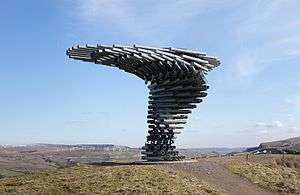 Panopticon: The Singing Ringing Tree
Panopticon: The Singing Ringing Tree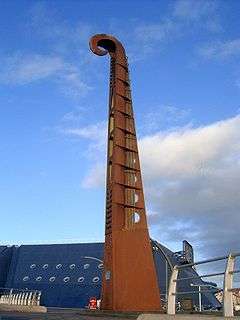 The Blackpool High Tide Organ
The Blackpool High Tide Organ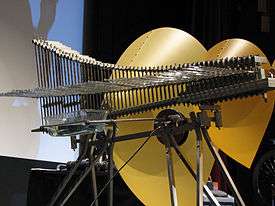 The Cristal Baschet
The Cristal Baschet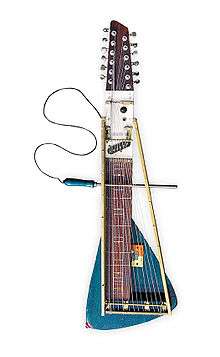 Yuri Landman, Moodswinger, 2006
Yuri Landman, Moodswinger, 2006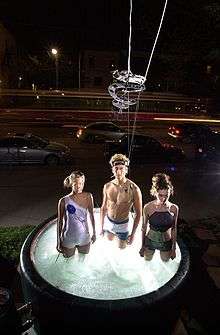
See also
- List of sound artists
- List of topics related to Sound Art
- Acousmonium
- Acoustic ecology
- Work of art
- Audium
- Electronic music
- Fluxus
- Installation art
- Intermedia
- NIME
- Noise Music
- Performance art
- Radio art
- Sonification
- Sound effect
- Sound installation
- Sound poetry
- Sound sculpture
- Soundscape
- Video game music
- Visual music
- Sound map
Notes
- Kenneth Goldsmith, Duchamp Is My Lawyer: The Polemics, Pragmatics, and Poetics of UbuWeb, Columbia University Press, New York, p. 125
- Atelier Brückner (2010). Scenography / Szenografie - Making spaces talk / Narrative Räume. Stuttgart: avedition. p. 209.
- Kenneth Goldsmith, Duchamp Is My Lawyer: The Polemics, Pragmatics, and Poetics of UbuWeb, Columbia University Press, New York, p. 136
- Dunaway, Judy (May 7, 2020). "The Forgotten 1979 MoMA Sound Art Exhibition". Resonance. doi:10.1525/res.2020.1.1.25. Retrieved 13 May 2020.
- Dunaway, Judy (May 7, 2020). "The Forgotten 1979 MoMA Sound Art Exhibition". Resonance. doi:10.1525/res.2020.1.1.25. Retrieved 13 May 2020.
- Herman, Jan, ed. (1974). Something Else Yearbook 1974. Barton, VT: Something Else Press.
- Dunaway, Judy (May 7, 2020). "The Forgotten 1979 MoMA Sound Art Exhibition". Resonance. doi:10.1525/res.2020.1.1.25. Retrieved 13 May 2020.
- "Museum of Modern Art, Museum exhibition features works incorporating sound, press release no. 42 for Sound Art exhibition 25 June–5 August 1979" (Exh. 1266). MoMA Archives.
- Hellerman and Goddard 1983, .
- "Transmediale". Berlin.de. Retrieved 24 January 2020.
- "About". Transmediale. Retrieved 24 January 2020.
References
- Kenneth Goldsmith, Duchamp Is My Lawyer: The Polemics, Pragmatics, and Poetics of UbuWeb, Columbia University Press, New York
- Hellerman, William, and Don Goddard. 1983. Catalogue for "Sound/Art" at The Sculpture Center, New York City, May 1–30, 1983 and BACA/DCC Gallery June 1–30, 1983.
- Kahn, Douglas. 2001. Noise, Water, Meat: A History of Sound in the Arts. Cambridge: MIT Press. ISBN 0-262-61172-4.
- Licht, Alan. 2007. Sound Art: Beyond Music, Between Categories (with accompanying compact disc recording). New York: Rizzoli International Publications. ISBN 0-8478-2969-3.
Further reading
- Attali, Jacques. 1985. Noise: The Political Economy of Music, translated by Brian Massumi, foreword by Fredric Jameson, afterword by Susan McClary. Minneapolis: University of Minnesota Press. ISBN 0-8166-1286-2 (cloth) ISBN 0-8166-1287-0 (pbk.)
- Bandt, Ros. 2001. Sound Sculpture: Intersections in Sound and Sculpture in Australian Artworks. Sydney: Craftsman House. ISBN 1-877004-02-2.
- Cage, John. 1961. "Silence: Lectures and Writings". Middletown, CT: Wesleyan University Press. (Paperback reprint edition 1973, ISBN 0-8195-6028-6)
- Cox, Christoph. 2003. "Return to Form: Christoph Cox on Neo-modernist Sound Art—Sound—Column." Artforum (November): [pages].
- Cox, Christoph. 2009. "Sound Art and the Sonic Unconscious". Organised Sound 14, no. 1:19–26.
- Cox, Christoph. 2011. "Beyond Representation and Signification: Toward a Sonic Materialism". Journal of Visual Culture 10, no. 2:145–161.
- Cox, Christoph, and Daniel Warner (eds.). 2004. Audio Culture: Readings in Modern Music. New York: Continuum. ISBN 978-0-8264-1615-5.
- Drobnick, Jim (ed.). 2004. Aural Cultures. Toronto: YYZ Books; Banff: Walter Phillips Gallery Editions. ISBN 0-920397-80-8.
- Hegarty, Paul. 2007. Noise Music: A History. New York: Continuum International Publishing Group. ISBN 978-0-8264-1726-8 (hardcover) ISBN 978-0-8264-1727-5 (pbk)
- Jensenius, Alexander Refsum; Lyons, Michael, eds. (2017). A NIME Reader: Fifteen Years of New Interfaces for Musical Expression. Springer. ISBN 978-3-319-47214-0.
- Kim-Cohen, Seth. 2009. In the Blink of an Ear: Toward a Non-Cochlear Sonic Art. New York: Continuum. ISBN 978-0-8264-2971-1
- LaBelle, Brandon. 2006. Background Noise: Perspectives on Sound Art. New York and London: The Continuum International Publishing Group. ISBN 0-8264-1844-9 (cloth) ISBN 0-8264-1845-7 (pbk)
- Lander, Dan, and Micah Lexier (eds.). 1990. Sound by Artists. Toronto: Art Metropole/Walter Phillips Gallery.
- Lucier, Alvin, and Douglas Simon. 1980. Chambers. Middletown, Connecticut: Wesleyan University Press. ISBN 0-8195-5042-6.
- Nechvatal, Joseph. 2000. "Towards a Sound Ecstatic Electronica". The Thing.
- Oliveros, Pauline. 1984. Software for People. Baltimore: Smith Publications. ISBN 0-914162-59-4 (cloth) ISBN 0-914162-60-8 (pbk)
- Paik, Nam June. 1963. "Post Music Manifesto," Videa N Videology. Syracuse, New York: Everson Museum of Art.
- Peer, René van. 1993. Interviews with Sound Artists. Eindhoven: Het Apollohuis.
- Rogers, Holly. 2013. Sounding the Gallery: Video and the Rise of Art-Music. Oxford: Oxford University Press.
- Schaefer, Janek, Bryan Biggs, Christoph Cox, and Sara-Jayne Parsons. 2012. "Janek Schaefer: Sound Art: A Retrospective". Liverpool: The Bluecoat. ISBN 978-0-9538896-8-6.
- Schafer, R. Murray. 1977. The Soundscape. Rochester, Vermont: Destiny Books. ISBN 0-89281-455-1
- Schulz, Berndt (ed.). 2002. Resonanzen: Aspekte der Klangkunst. Heidelberg: Kehrer. ISBN 3-933257-86-7. (Parallel text in German and English)
- Skene, Cameron. 2007. "Sonic Boom". The Montreal Gazette (13 January).
- Toop, David. 2004. Haunted Weather: Music, Silence, and Memory. London: Serpent's Tail. ISBN 1-85242-812-0 (cloth), ISBN 1-85242-789-2 (pbk.)
- Valbonesi, Ilari. A.A.A.A.A.A.A. Cercasi Sound Art. ARTE E CRITICA, ISSUE 64, (2010)
- Wilson, Dan. 2011. "Sonics in the Wildernesses – A Justification." The Brooklyn Rail (April)
- Wishart, Trevor. 1996. On Sonic Art, new and revised edition, edited by Simon Emmerson (with accompanying compact disc recording). Contemporary Music Studies 12. Amsterdam: Harwood Academic Publishers. ISBN 3-7186-5846-1 (cloth) ISBN 3-7186-5847-X (pbk.) ISBN 3-7186-5848-8 (CD recording)